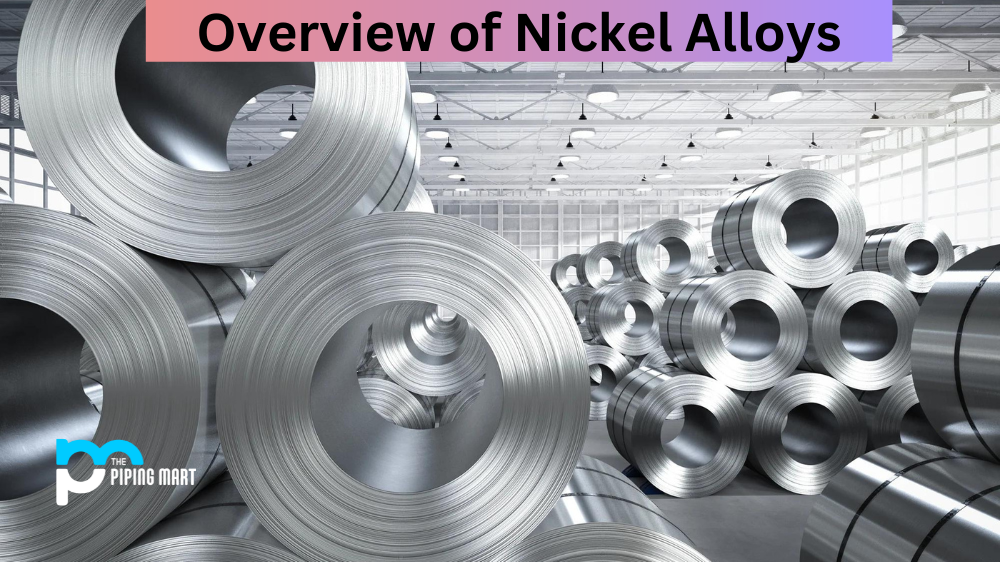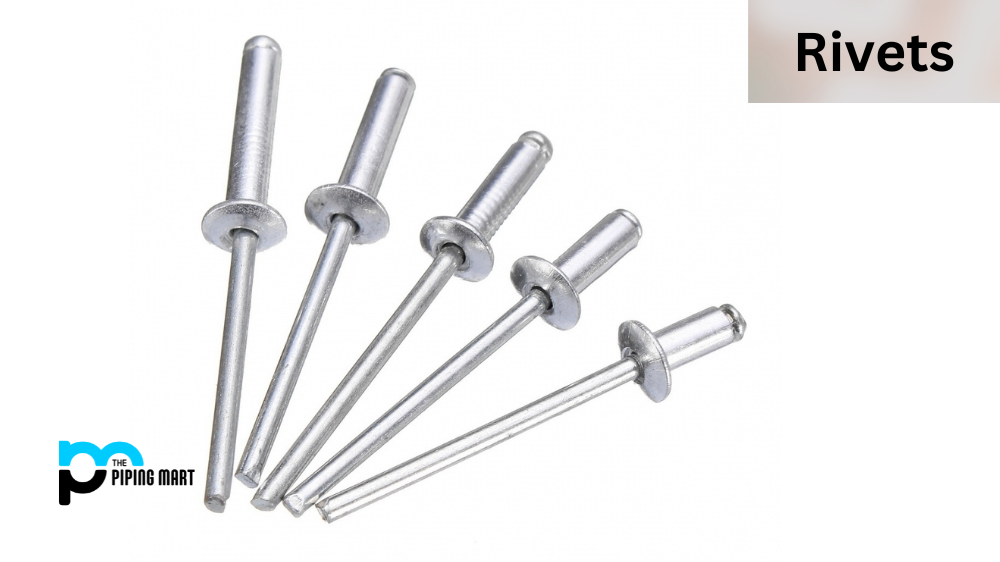Nickel alloys are a type of metal composed of nickel and other metals, such as iron, copper, and chromium. Nickel alloys are incredibly versatile and can be used in a variety of applications. Let’s take a look at what makes nickel alloys so special, their uses, composition, melting point, density, and classification.
What are Nickel Alloys?
Nickel alloy is a type of metal that consists of nickel and at least one other element such as iron, copper, or titanium. These alloys can be formed into various shapes, ranging from wires and sheets to piping and housing for electrical equipment. They are known for their exceptional resistance to corrosion, high-temperature strength, and excellent mechanical properties. This makes nickel alloy a popular choice for a wide range of applications, including aerospace, chemical processing, marine engineering, and energy production. Nickel alloys are also commonly used in medical equipment, as they are biocompatible and resistant to corrosion from bodily fluids. With their unique properties and versatility, it’s no wonder that nickel alloys have become one of the most important materials in modern industrial applications.
Nickel Alloys Uses
Nickel alloys are known for their excellent corrosion resistance due to their strong bond between the metals in the alloy. They also have great strength and toughness that makes them ideal for use in applications that require wear resistance or high temperatures. Common uses for nickel alloys include aerospace components, medical implants, marine equipment, valves and pumps, oil and gas production equipment, turbine engines, and nuclear power plant components.
Nickel Alloy Composition
A nickel alloy is composed of two or more metals, with one being nickel as the base metal. The other metals that often form part of an alloy may include iron (Fe), copper (Cu), manganese (Mn), chromium (Cr), molybdenum (Mo) titanium (Ti). Each different combination will result in different properties depending on the purpose it is intended to serve; this is why there are many types of nickel alloys available on the market today. For example, Hastelloy C276 contains an alloy made up mostly of nickel along with molybdenum, chromium, and tungsten, which makes it resistant to corrosion from many types of acids & chemicals.
A nickel alloy composition chart is a tool used to compare the chemical makeup of different types of nickel alloys. This chart provides information on the percentages of various elements that go into each alloy; this includes both metallic elements (such as nickel, cobalt, iron, etc.) as well as non-metallic elements (such as carbon, boron, sulfur, etc.). By comparing these percentages across different types of alloys, you can gain insight into how each one behaves differently in various conditions or applications.
| Nominal Chemical Compositions of Nickels and Nickel Alloys | |||||||
|---|---|---|---|---|---|---|---|
| Nominal Composition wt. % | |||||||
| Nickel | Copper | Iron | Manganese | Carbon | Silicon | Sulfur | |
| Nickel 200 | 99.0min | 0.25max | 0.40max | 0.35max | 0.15max | 0.35max | 0.010max |
| Monel 400 | 63.0min | 28.0-34.0 | 2.50max | 2.00max | 0.30max | 0.50max | 0.024max |
| Inconel 600 | 72.0min | 0.50max | 6.00-10.00 | 1.00max | 0.15max | 0.50max | 0.015max |
| Inconel 601 | 58.0-63.0 | 1.00max | Bal. | 1.00max | 0.10max | 0.50max | 0.015max |
| Inconel 625 | 58.0min | 5.00max | 0.50max | 0.10max | 0.50max | 0.015max | |
| Incoloy 800 | 30.0-35.0 | 0.75max | 39.50min | 1.50max | 0.10max | 1.00max | 0.015max |
| Incoloy 800H | 30.0-35.0 | 0.75max | 39.50min | 1.50max | 0.05-0.10 | 1.00max | 0.015max |
| Incoloy 800HT | 30.0-35.0 | 075max | 39.5min | 1.50max | 0.06-0.10 | 1.00max | 0.015max |
| Incoloy 803 | 32.0-37.0 | 0.75max | Bal. | 1.50max | 0.06-0.10 | 1.00max | 0.015max |
| Incoloy 825 | 38.0-46.0 | 1.50-3.00 | 22.00min | 1.00max | 0.05max | 0.50max | 0.03max |
| C-276 | Bal. | 4.00-7.00 | 1.00max | 0.01max | 0.08max | 0.03max | |
| Alloy 020 | 32.00-38.00 | 3.00-4.00 | Bal. | 2.00max | 0.07max | 1.00max | 0.035max |
| Cobalt | Aluminum | Titanium | Chromium | Molybdenum | Tungsten | Vanadium | |
| Nickel 200 | |||||||
| Monel 400 | |||||||
| Inconel 600 | 14.0-17.0 | ||||||
| Inconel 601 | 1.00-1.70 | 21.0-25.0 | |||||
| Inconel 625 | 1.00max | 0.40max | 0.40max | 20.00-23.00 | 8.00-10.00 | ||
| Incoloy 800 | 0.15-0.60 | 0.15-0.60 | 19.0-23.0 | ||||
| Incoloy 800H | 0.15-0.60 | 0.15-0.60 | 19.0-23.0 | ||||
| Incoloy 800HT | 0.85-1.20 | 0.25-0.60 | 19.0-23.0 | ||||
| Incoloy 803 | 0.15-0.60 | 0.15-0.60 | 25.0-29.0 | ||||
| Incoloy 825 | 0.20max | 0.60-1.20 | 19.50-23.50 | 2.50-3.50 | |||
| C-276 | 2.50max | 14.50-16.50 | 15.00-17.00 | 3.00-4.50 | 0.35max | ||
| Alloy 020 | 19.00-21.00 | 2.00-3.00 | |||||
| Phosphorus Niobium+Tantalum | |||||||
| Nickel 200 | |||||||
| Monel 400 | |||||||
| Inconel 600 | |||||||
| Inconel 601 | |||||||
| Inconel 625 | 0.015max | 3.15-4.15 | |||||
| Incoloy 800 | |||||||
| Incoloy 800H | |||||||
| Incoloy 800HT | |||||||
| Incoloy 803 | |||||||
| Incoloy 825 | |||||||
| C-276 | 0.04max | ||||||
| Alloy 020 0.045max 8xC-1.00 | |||||||
Benefits of Using a Nickel Alloy Composition Chart
Using a nickel alloy composition chart can help engineers and scientists identify which type of alloy is best suited for their needs. For example, if you need an alloy with higher levels of corrosion resistance than others on the market, you can use the chart to identify which ones contain higher amounts of chromium or molybdenum – two elements known for their ability to resist oxidation from moisture or other corrosive agents. Additionally, by knowing which specific components make up each type of alloy on the chart (and in what percentages), it becomes easier to predict how those components will interact with each other over time – helping engineers design more reliable products for their customers.
Conversely, knowing which elements should be avoided in certain alloys can also be beneficial. Some metals like lead or zinc are known to weaken an alloy’s strength over time; by avoiding them altogether (or only using them in small amounts), it may be possible to create an alloy that has superior performance characteristics compared to its competitors.
Machining Nickel Alloy
When machining nickel alloys, it’s important to use sharp tools that are designed specifically for working with hard materials like this one. The cutting tools should also be properly lubricated while machining as this can reduce friction and wear on the tooling as well as improve surface finish quality. Additionally, lower speeds should be used when machining these materials to prevent overheating or work-hardening of the material, which could lead to decreased performance or even failure of the final product.
It’s also important to use a rigid setup when machining nickel alloys to prevent vibration or chatter which can cause poor surface finish quality or reduce tool life significantly. Additionally, a steady feed rate is recommended as sudden changes in feed rate can cause excessive heat buildup, which can cause warping or cracking of machined material. Finally, keeping a close eye on your cutting tool during machining operations is important. These materials tend to wear down tools quickly, so regular inspection is key for optimal performance.
Nickel Alloy Melting Point
The melting point of a particular nickel alloy depends on its composition; however, most commonly used ones melt at temperatures between 1450°C – 1560°C (2642°F – 2840°F). Generally speaking, the higher the content of nickel in an alloy, the higher its melting point will be. This property makes them well-suited for welding applications where high temperatures are needed to join pieces together without weakening them or adversely affecting their properties.
Nickel Alloy Density
The density of a particular type of nickel alloy will depend on its exact composition, but generally, they range from 7-9 g/cm3, with pure nickel having a density of around 8g/cm3. This means they can be used in applications where weight is important such as aerospace components where lighter materials are preferred to reduce fuel consumption costs or increase speed potential while still providing the strength & durability required for these types of items.
Classification Of Nickel Alloys
Nickel alloys can be classified according to their chemical composition or mechanical properties, such as tensile strength or fatigue resistance. Common classifications include austenitic stainless steels, which contain high levels of chromium & low levels of carbon; ferritic stainless steels, which contain low levels of chromium & no molybdenum; martensitic stainless steels, which contain high levels of molybdenum & low levels carbon; duplex stainless steels which contain equal amounts both ferrite & austenite phases in their microstructure; precipitation hardening stainless steel which has good mechanical properties at elevated temperatures due to its specially designed chemical composition; superalloy steels which have superior creep resistance under high-stress conditions at elevated temperature due to their special chemistry blend; and lastly was alloy variants which combine good oxidation resistance with exceptional strength making them perfect for jet engine components.
Conclusion:
Nickel alloys offer superior corrosion resistance along with excellent mechanical properties when compared to regular steel or aluminum, making them ideal for specific applications such as aerospace components or medical implants where lightweight materials need to withstand extreme conditions without failure over time. Their versatility means they can be tailored by varying their chemical composition so each application can get exactly what it needs from these specialized materials without sacrificing performance quality or safety standards set by governing bodies worldwide. With so many variations available, you’re sure to find one that fits your needs perfectly!

Pipingmart is a B2B portal that specializes in metal, industrial and piping items. Additionally, we share the latest information and information about materials, products and various types of grades to assist businesses that are involved in this business.




